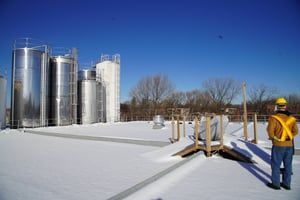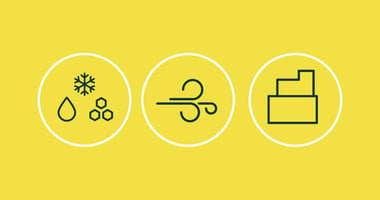How Tensio Optimizes Roof Snow Removal with AI
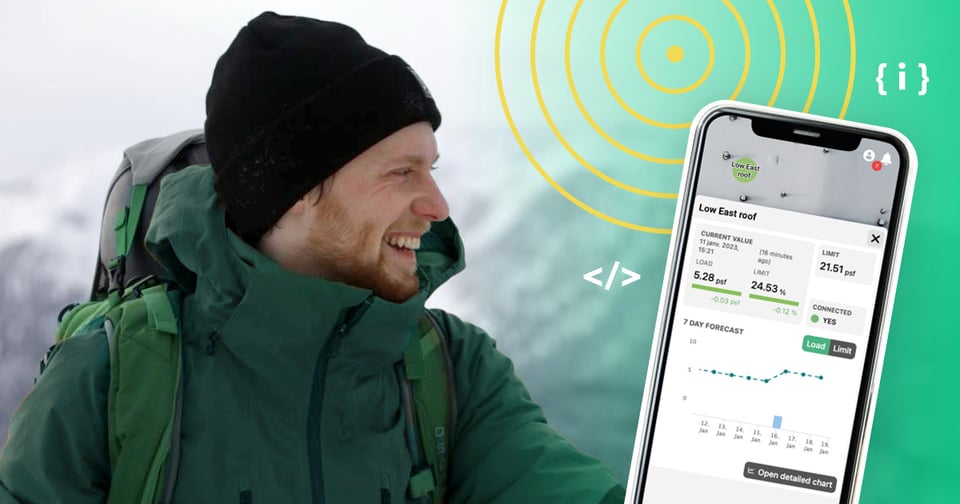
Above: Sacha Fabien, Product Manager at Tensio.
The Tensio preventive maintenance solution is an innovative and advanced technology that has been developed by our experts in building structure and software development. However, innovation also comes with a certain level of complexity. Various factors must be considered when deciding whether to remove snow or not, and this information is not always easily accessible. The functioning of such technology may therefore appear unclear to the general public.
To shed light on the Tensio system, Sacha Fabien, product manager at Tensio, granted us an interview. Sacha played a key role in the system's design and is still actively involved in its development today. Here is what he had to say:
Hi Sacha! Before we get into the heart of the matter, could you briefly explain your role within Tensio?
A: In my role as a Product Manager at Tensio, I engage with our clients to gather valuable feedback on our product. This input serves as a foundation for enhancing our offering to better align with customer needs. Additionally, my background as a mechanical engineer puts me in a good position to contribute to product design, and I play a pivotal role in developing Tensio's predictive model. As a skiing enthusiast with knowledge of avalanches, I have found many parallels between our system and the factors to consider when assessing avalanche risks. These insights and intuitions have significantly impacted the system's design, making it more robust and effective.
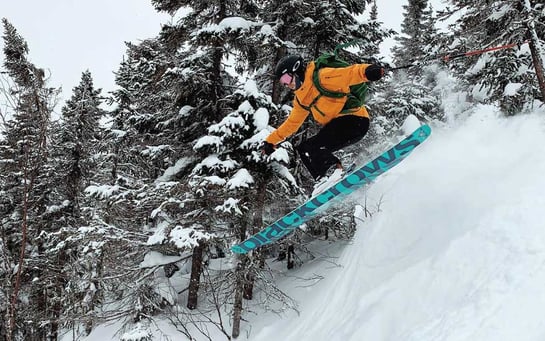 Above: Sacha loves spending his days skiing when he's not busy writing lines of code!
Above: Sacha loves spending his days skiing when he's not busy writing lines of code!
Perfect! So, with your expertise and experience gained in the company, could you describe what climate resilience is? Tensio is described as a climate resilience tool. What does this term mean and how does Tensio come into play?
A: Climate resilience is about adapting to increasingly unpredictable weather conditions. Climate change introduces significant fluctuations in meteorological patterns. For instance, temperatures can plummet to -15°C with a meter of snowfall one day, only to be followed by rain the next day. Consequently, weather conditions have become more erratic than in the past, significantly affecting the accumulation of snow on building roofs.
We've got to figure out how to make the best choices, even when unexpected challenges come our way. Tensio is a solution that optimally withstands these extreme weather conditions by predicting when to clear snow. The system considers a multitude of factors to accurately decide the perfect time for roof snow removal – that's what we call climate resilience in action.
Okay, it's clearer now! You're talking about the factors that are taken into account by the system, what are these factors?
A: Navigating this calculation involves considering a lot of factors, making it quite complex! However, certain factors carry significant weight – quite literally – and exert influence. The anticipated snowfall volume is undeniably a crucial factor.
Next, our application's predictions incorporate a mix of elements, including roof geometry and wind patterns. For instance, roofs with walls perpendicular to prevailing winds tend to accumulate more snow in specific areas, as the wind directs it towards lower sections. This principle mirrors that of avalanches and the alignment of mountains with wind gusts.
Learning how these phenomena impact snow accumulation is possible through the large amount of data we have collected through our sensors installed in buildings across the country.
The machine learning system also factors in predicted humidity and the day's maximum temperature. These variables play a vital role in determining the type of snow cover – whether it's prone to being swept away by the wind. When I go skiing and need to assess avalanche risks, it's essentially these same factors that are taken into account. Additionally, historical weather conditions from the past month, along with the system's responses to them, contribute to the data stored for predictive analysis.
Now that we know these factors, how are they calculated to determine whether a roof should be cleared of snow or not? Tensio is an autonomous system, so how does the system handle the data?
A: The system is based on a neural network that accumulates and processes the collected data, and this neural network is based on a transformer.
To illustrate what a transformer is, let's take the example of ChatGPT, a popular conversational agent. This artificial intelligence tool operates on the same principle as a transformer. So, when we input words to request something from ChatGPT, it transforms those words into a response using other words. Essentially, it's all about transforming words into words.
For Tensio, the transformer is a key player. It processes quantifiable physical data such as snow volume, humidity, wind speed and direction, roof structure, and more. The output? Transformed data that specifically reflects the weight of snow on the roof. This transformation enables us to assess whether snow removal is necessary, taking the building's constraints into account.
The predictive accuracy of this model is significantly enhanced – it's five times more precise than our previous approach, which solely focused on anticipated snowfall.
We're delving into artificial intelligence, a relatively recent development that holds numerous advantages for a system like Tensio. Can you highlight the primary contrast in the system since incorporating AI?
R : A: Yes, AI enables us to utilize data from our sensors and create a predictive model that factors in numerous elements that would be challenging to reconcile otherwise. This model accounts for the roof's structure and the characteristics of the snow in its predictions, a feat that would have been impossible without AI.
Additionally, with the aid of AI leveraging historical and present data, we can now quantify snow melting, which is a huge gain. Taking these details into consideration is a game-changer, giving us the ability to make more accurate predictions that really matter to our clients.
Okay. This data will then be interpreted on the application in percentages. What do these percentages mean?
R : A: The percentages are determined using scales aligned with the building code. When the application shows 100%, it signifies that the structure has reached its maximum capacity according to the building code, indicating the need for snow removal. Anticipating our requirements and coordinating operations before hitting the 100% mark is crucial. Since snowfall impacts everyone simultaneously, waiting until 100% might risk unavailability of the workforce. It serves as an additional safety measure.
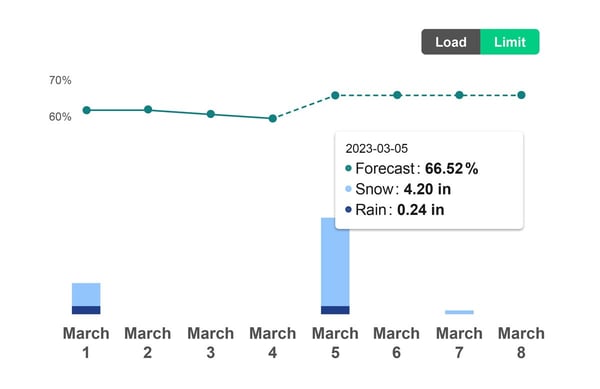
Above: Display of snow and rain load percentages in the weather forecast module of the Tensio app.
In some cases, it might be crucial to initiate snow removal earlier than usual. Take a big building with a flat roof – that job takes time. If a storm is on the horizon, it's smart to kick off the snow removal as early as possible. Thanks to AI predictions, we can stay ahead of the game, knowing exactly when and where we'll need to clear the snow.
Sacha, I appreciate you taking the time for this interview. Your expertise will allow many people to better understand how Tensio's technology works!
We've covered a bunch about how Tensio works – from collecting data to showing predictions on the app. If you have any additional questions, feel free to reach out through the chat (you'll find a green icon in the bottom right corner of the screen) or request a personalized demo.
%20(2).png?width=150&height=50&name=Tensio_Logo-SansPositionnement_RVB%20(1)%20(2).png)
